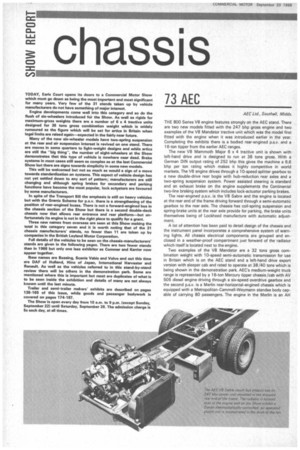chassis
Page 120

Page 121

If you've noticed an error in this article please click here to report it so we can fix it.
73 AEC
AEC Ltd., Southall, Middx. TODAY, Earls Court opens its doors to a Commercial Motor Show which must go down as being the most important and most significant for many years. Very few of the 31 stands taken up by vehicle manufacturers do not have something of major interest.
Engine developments come well into this category and so do the flush of six-wheelers introduced for the Show. As well as rigids for maximum-gross weights there are a number of 6 x 4 tractive units designed for 38 tons gross combination weight which is widely rumoured as the figure which will be set for artics in Britain when legal limits are raised again—expected in the fairly near future.
Many of the new six-wheeler models have two-spring suspension at the rear and air suspension interest is revived on one stand. There are moves in some quarters to light-weight designs and while attics are still the "big thing", the number of eight-wheelers at the Show demonstrates that this type of vehicle is nowhere near dead. Brake systems in most cases still seem as complex as at the last Commercial Show but there are signs towards simplicity in some new models.
This will be welcomed but not so much as would a sign of a move towards standardisation on systems. This aspect of vehicle design has not yet settled down to any sort of pattern; manufacturers are still changing and although spring brakes for secondary and parking functions have become the most popular, lock actuators are favoured by some manufacturers.
In spite of the Transport Bill the emphasis is still on heavy vehicles but with the Grants Scheme for p.s.v. there is a strengthening of the position of rear-engined buses. There is not a forward-engined bus in the chassis section of the Show but there is a second double-deck chassis now that allows rear entrance and rear platform—but unfortunately its engine is not in the right place to qualify for a grant.
Three new names from overseas are seen at this Show making the total in this category seven and it is worth noting that of the 31 chassis manufacturers' stands, no fewer than 11 are taken up by companies in the British Leyland Motor Corporation.
Full details of the vehicles to be seen on the chassis-manufacturers' stands are given in the following pages. There are two fewer stands than in 1966 but only one less exhibitor as Commer and Kamer now appear together.
New names are Bussing, Scania Vabis and Volvo and out this time are OAF of Holland, Hino of Japan, International Harvester and Renault. As well as the vehicles referred to in this stand-by-stand review there will be others in the demonstration park. Some are mentioned where this is important but most are duplicates of what is to be seen inside the exhibition and details of many are not always known until the last minute.
Trailer and semi-trailer makers' exhibits are described on pages 138-165 of this issue, while goods and passenger bodywork is covered on pages 174-187.
The Show is open every day from 10 a.m. to 9 p.m. lexcept Sunday, September 22) until Saturday. September 28. The admission charge is 5s each day, at all times.
THE 800 Series V8 engine features strongly on the AEC stand. There are two new models fitted with the 247 bhp gross engine and two examples of the V8 Mandator tractive unit which was the model first fitted with the engine when it was introduced earlier in the year. Completing the exhibits there is a bodied rear-engined p.s.v. and a 16-ton tipper from the earlier AEC ranges.
The new V8 Mammoth Major 6 x 4 tractive unit is shown with left-hand drive and is designed to run at 38 tons gross. With a German DIN output rating of 252 bhp this gives the machine a 6.6 bhp per ton rating which makes it highly competitive in world markets. The V8 engine drives through a 10-speed splitter gearbox to a new double-drive rear bogie with hub-reduction rear axles and a two-spring suspension system. Power assisted steering is standard and an exhaust brake on the engine supplements the Continental two-line braking system which includes lock-actuator parking brakes.
The rear-angined p.s.v.. is the V8 Sabre and the engine is located at the rear end of the frame driving forward through a semi-automatic gearbox to the rear axle. The chassis has coil-spring suspension and spring-brake units at the rear axle provide for parking, the brake units themselves being of Lockheed manufacture with automatic adjustment.
A lot of attention has been paid to detail .design of the chassis and the instrument panel incorporates a comprehensive system of warning lights. All chassis electrical components are grouped and enclosed in a weather-proof compartment just forward of theradiator which itself is located next to the engine.
Two examples of the V8 Mandator are a 32 tons gross combination weight with 10-speed semi-automatic transmission for use in Britain which is on the AEC stand and a left-hand drive export version with sleeper cab and rated to operate at 38/40 tons which is being shown in the demonstration park. AEC's medium-weight truck range is represented by a 16-ton Mercury tipper chassis/cab with AV 505 diesel engine driving through a six-speed overdrive gearbox and the second p.s.v. is a Merlin rear-horizontal-engined chassis which is equipped with a Metropolitan-Cammell-Weymann standee body capable of carrying 80 passengers. The engine in the Merlin is an AH 691 and the chassis has fully-automatic transmission and power assisted steering being designed for use by London Transport and based on the design of the Swift rear-engined bus.
As well as the chassis AEC has sectioned examples of the 800 Series V8 and the new lockable differentials used in the V8 Mandator for the home market on its stand.


















































































































































































































































































































































































